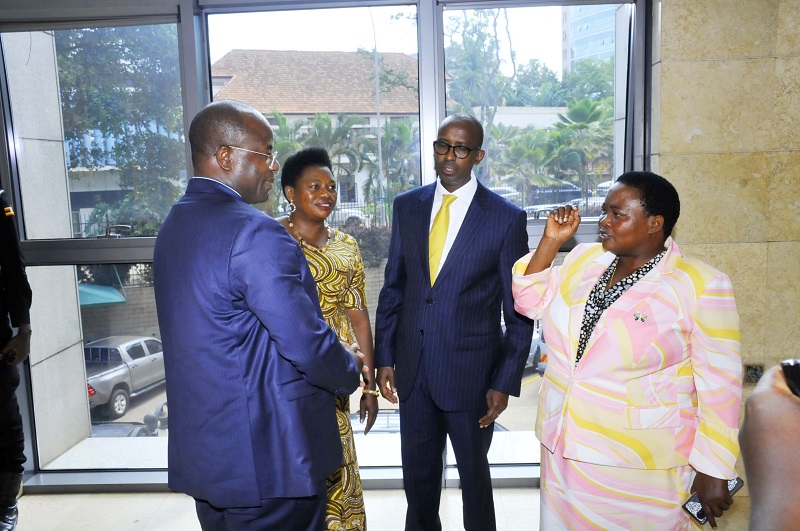
Uganda's prime minister, Ruth Nabbanja talking to investors who have been brought in through the Presidential Advisory Committee on Exports and Industrial Development (PACEID). She is expected to officially launch the 600MW dam
Uganda’s prime minister, Ruth Nabbanja talking to investors who have been brought in through the Presidential Advisory Committee on Exports and Industrial Development (PACEID). She is expected to officially launch the 600MW dam
Kampala, Uganda I HABARI DAILY I Uganda is on the cusp of a major transformation in its electricity sector with the impending unveiling of the Karuma Hydroelectric Power Station. This ambitious 600 MW project, situated on the Victoria Nile, is poised to become the largest power-generating installation in the country. Not only will it make Uganda power independent, but it also holds the potential to turn the nation into a major power exporter within the region, bringing in millions of dollars annually.
The Ministry of Energy and Mineral Development recently issued a statement revealing that the overall progress of the Karuma Hydroelectric Power Station stands at an impressive 99.6%. The Reservoir Affected Persons (RAP) component is at 85%, while two units have already been commissioned. Unit 1 began operations in April 2023, followed by Unit 4, which was commissioned this month.
Dr. Ruth Nankabirwa Ssentamu, the Minister of Energy, believes that the Karuma project will have far-reaching benefits for Uganda. It will significantly improve electricity access, lower transmission losses, enhance power efficiency, reliability, stability, and quality of supply nationwide. Moreover, the power station is expected to facilitate the evacuation of power from upcoming solar fields and other power plants, further boosting Uganda’s energy capacity.
The development of the Karuma power project aligns with Uganda Vision 2040, a comprehensive plan approved by the Cabinet in 2007. This vision aims to transform Uganda from a peasant society to a modern and prosperous country within 30 years. Central to this transformation is the generation of affordable electricity, utilizing the estimated 4,500 MW hydro power potential across various rivers in the country, including small, mini, and large hydro power plants.
Uganda’s Vision 2040 recognizes that energy, particularly electricity, is a crucial driver of socio-economic transformation. As such, the government is committed to developing and harnessing diverse sources of energy to fuel growth. By 2040, Uganda aims to generate 41,738 MW, with an estimated per capita consumption of 3,668 kWh.
Minister Nankabirwa emphasizes that the Karuma Hydroelectric Power Station will not only improve electricity access in both rural and urban areas but also contribute significantly to the country’s total installed capacity. This will enable authorities to connect more Ugandans to the national grid, fostering economic development and prosperity.
The Ministry of Energy plays a pivotal role in implementing the National Development Plan (NDP) III programs. Their mission is to establish, promote, strategically manage, and safeguard the rational and sustainable exploitation of energy and mineral resources for social and economic development. Eng. Irene Bateebe, the Permanent Secretary of the ministry, highlights the importance of the energy development program in unlocking industrialization, investment, social services provision, and overall competitiveness and productivity of the economy.
In addition to the energy sector, the ministry also focuses on mineral development and petroleum resources. These programs aim to drive manufacturing, technology development, and promote private investment. They seek to strengthen legal and regulatory frameworks, enhance local capacity, improve quality health, safety, security, and environment (QHSSE), and ensure the security of the supply of refined petroleum products.
Uganda’s sustainable energy initiatives extend beyond hydroelectric power. The government is actively promoting the development of nuclear, solar, wind, and geothermal energy resources to diversify the energy mix and increase the proportion of renewables. Furthermore, plans are underway to construct a Center for Nuclear Science and Technology at Soroti University, with ongoing efforts to identify suitable sites for the Buyende Nuclear Power Project.
Significant strides have also been made in expanding Uganda’s power transmission and distribution infrastructure. Over 400 kilometers of high voltage transmission lines have been added to the grid, along with the commissioning of new substations. This has contributed to an increase in electricity generation capacity, which currently stands at 1,378.1 MW, with a further boost expected when the Karuma Hydroelectric Power Station comes online in September 2023.
To make electricity more affordable, the government has introduced innovative tariff schemes. A reducing/declining block tariff was implemented, which lowers the unit cost of electricity for consumers who use more units. Additionally, a cooking tariff was introduced to provide affordable cooking solutions. These initiatives have resulted in an increase in the number of consumers connected to the grid, with access to energy now reaching 57%.
The government is determined to further improve energy access through projects like the Electricity Access Scale-Up Project (EASP). This project aims to connect households, commercial enterprises, public institutions, mining centers, and industrial parks to the grid, creating a demand for up to 500 MW.
As Uganda marches toward Vision 2040, installations like the Karuma Hydroelectric Power Station are pivotal in transforming the lives of millions of citizens. With its completion on the horizon, Uganda is on track to become not only power independent but a regional powerhouse in the energy sector, driving economic growth and prosperity for years to come.
CAPTION: Uganda’s prime minister, Ruth Nabbanja talking to investors who have been brought in through the Presidential Advisory Committee on Exports and Industrial Development (PACEID). She is expected to officially launch the 600MW dam




